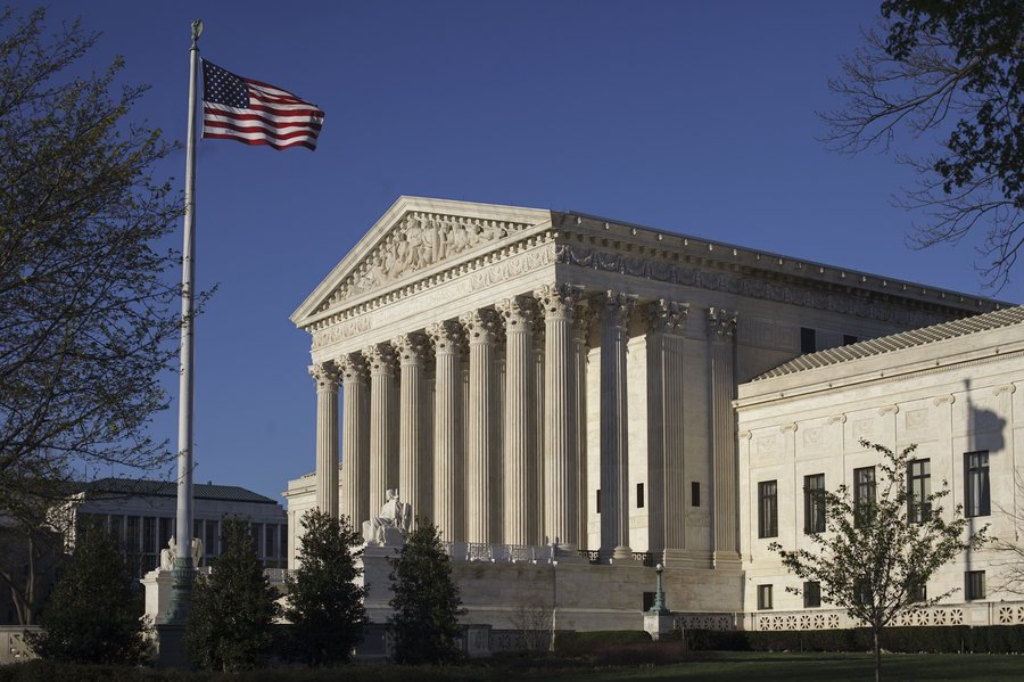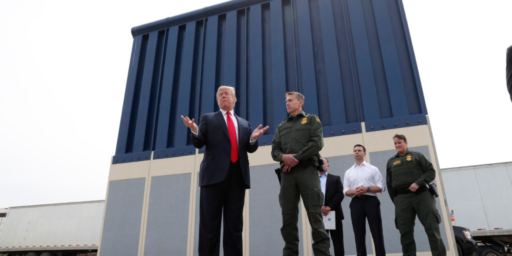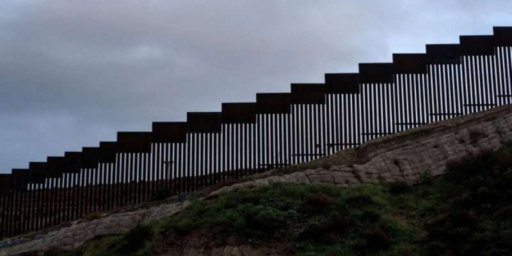SCOTUS Refuses to Block Trump’s Illegal Wall
The Supreme Court isn't taking much of a break this year.

While officially out of session, a never-ending series of emergency requests are keeping the nation’s highest court busy. Yesterday, they refused to lift their own stay on lower court rulings that President Trump’s theft of Defense Department funds to build a border wall was illegal.
The Hill (“Supreme Court declines to halt Trump border wall“):
The Supreme Court on Friday declined to block the Trump administration from using $2.5 billion in reallocated Pentagon funds to build a U.S.-Mexico border wall.
In a 5-4 ruling that broke along ideological lines, the court’s conservative majority denied a bid by interest groups to halt construction after a federal appeals court last month said the use of defense funding for the project is illegal. The court’s four more liberal justices dissented from the ruling.
The Sierra Club, American Civil Liberties Union (ACLU) and other challengers had asked the justices to lift their order from last July that allowed President Trump to begin spending the funds while legal challenges proceeded through the courts.
But the Friday ruling means the court’s July 2019 order, also decided 5-4, remains in effect despite a ruling by a federal appeals court in California last month that Trump’s diversion of defense, military and other funding was unconstitutional.
Justice Stephen Breyer, in dissent, said he feared the majority’s ruling “may operate, in effect, as a final judgment.”
Legal challenges arose early last year after Trump declared a national emergency at the southern border to free up additional funding. That came after a congressional spending bill allocated some $1.3 billion for border security, far short of the nearly $5 billion Trump said was needed to complete his signature project.
Trump then reallocated $2.5 billion in funding that Congress appropriated for defense and military uses.
A federal district court halted use of the reappropriated funds. But the Supreme Court’s July 2019 ruling allowed construction to move forward while the case proceeded through the courts.
Last month, a divided three-judge panel of the 9th Circuit Court of Appeals in California ruled against Trump’s financing maneuver.
The court said the administration had violated the Appropriations Clause of the Constitution, which gives Congress the exclusive power of the purse. The decision affirmed a lower court’s injunction against the use of defense funds to build the wall.
“These funds were appropriated for other purposes, and the transfer amounted to ‘drawing funds from the Treasury without authorization by statute and thus violating the Appropriations Clause,’ ” the majority wrote. “Therefore, the transfer of funds here was unlawful.”
Almost exactly a year ago, our erstwhile colleague Doug Mataconis analyzed the original stay order in a post titled “Supreme Court Backs Trump On Border Wall Funding, For Now.” Essentially, they were sympathetic to the Government’s position that they needed to spend the money before the end of the fiscal year and dubious of the Sierra Club’s standing to bring the case. Fair enough.
But the rationale for the stay was also to let the Government exhaust its appeal. They have now lost a second time, in the 9th Circuit. So, the ostensible rationale is moot.
As is customary in these rulings, the majority did not issue an opinion explaining its decision. Justice Breyer wrote a very short dissent, signed by all his Democrat-appointed colleagues:
Just over a year ago, I suggested “a straightforward way” to avoid irreparable harm to the parties in this litigation: stay the District Court’s injunction “only to the extent” that it “prevents the Government from finalizing [relevant] contracts or taking other preparatory administrative action, but leave [the injunction] in place insofar as it precludes the
Government from disbursing those funds or beginning construction.” Trump v. Sierra Club, 588 U. S. , -_ (2019) (slip op., at 2-3) (opinion concurring in part and dissenting in part from grant of stay).Now, the Government has apparently finalized its contracts, avoiding the irreparable harm it claimed in first seeking a stay. The Court’s decision to let construction continue nevertheless, I fear, may “operat[e], in effect, as a final judgment.” Id., at _ (slip op., at 2). I would therefore lift the Court’s stay of the District Court’s injunction.
As always, I must caveat that I’m a political scientist and not an attorney. But the whole case strikes me as bizarre.
First and foremost, Trump’s actions here are so plainly illegal that they shouldn’t survive summary judgment. If Presidents can simply take any money Congress appropriates for anything and spend it however they wish, the Constitution is stood on its head.
Second, however, it seems rather obvious that the Sierra Club lacks standing to sue on those grounds.
Third, Breyer is right: By allowing Trump to continue blatantly illegal actions another year—despite both the trial court and the appeals court ruling that they were in fact blatantly illegal—the majority essentially renders the case moot. Indeed, it’s possible the money has already been spent. What’s the remedy in that case?
Beyond that, it just strikes me as bad precedent. We have, by proxy, a rather serious Constitutional standoff between the two politically-elected branches. The judiciary has twice ruled on the matter but the highest court has stayed both orders, allowing the losing side to effectively win.
But now what? Is the majority effectively promising to grant certiorari on the case? If so, the money will almost certainly be spent by the time there’s a ruling on the merits. If not, they’ve thwarted the seemingly obvious rulings by the lower court without offering any precedential rationale.





James, I think the reason you find this bizarre is you still cling to the archaic notion that the Republicans on the court are acting as Supreme Court Justices of the United States of America and not as mere partisans. So I ask you, in all seriousness, would this decision and dozens of others be less bizarre if viewed through a partisan lens? And if so, isn’t that the obvious conclusion?
The SCOTUS: Building the Case for Court Expansion.
Don’t worry. Once Biden is in office, the majority will suddenly remember that anything the executive branch wants to do is unconstitutional.
This is my shocked face, :-/
He can’t. The law allows the President, after declaring an emergency situation, to take funds appropriated for military construction of quite limited types and use them for different construction. That’s not an unreasonable grant of authority: “We appreciate that there may be times when, eg, you need an airstrip more than you need to refurbish barracks, and sooner than you can come to Congress to make the case.”
Like so much statute, it’s drafted under an assumption that the executive will act in good faith. Which didn’t happen here. My take on the events is that Trump deployed the military to the border so that he could assert an emergency in which they were threatened without additional construction, then selected a wall as the needed protective construction. Every bit of it against the advice and opinions of the generals. I suspect that eventually the SCOTUS will find it was a ruse but decide that it falls within the law as written.
@MarkedMan:
Sure, that’s a simple answer. The Republicans all voted one way and the Democrats all voted the other. The problem with that lens, though, is that, on many, many cases, they don’t follow that pattern. Thus, I’m assuming that, despite partisan and ideological biases, they’re actually ruling on a case-by-case basis.
@Michael Cain:
Yes, of course. But, not only was it a transparent ruse, as both the trial court and the 9th Circuit ruled, it was not only not an unforeseen military requirement but the Administration had specifically petitioned Congress for the money and been rebuffed.
@James Joyner:
Any idea what percentage of cases are split along party lines? I get the sense most are, but there’s still a big difference between say 95% split along party lines vs 50%.
Its kind of interesting how partisan the American court is. In Canada, despite our politics being as partisan as yours, our supreme court is almost a complete non-issue, to the point where even politically interested people couldn’t name more than one of our justices. Very few (I can’t recall a single one) if any Canadian supreme court decisions are based on party politic, and I suspect the same is true for European countries. How did the American court become so partisan?
@wr: “Don’t worry. Once Biden is in office, the majority will suddenly remember that anything the executive branch wants to do is unconstitutional.”
Seconded. And (Republican) Congressional subpoenas are legally binding, including those made by the (Republican) Minority leaders).
The really awful thought is that this case is not the last of it’s type. As we draw closer to Nov 3d and there are more and more straws in the wind that contesting the election is a significant part of the Administration’s strategy it emboldens those Administration figures who might be advocating simply stealing the national government. This is Bush v Gore on steroids. And frankly ought to scare the hell out of anyone who believes in our democracy.
Not a lawyer Northerner but I believe the short answer is that the Senate let the Federalist Society (I think those are the guys that come up with “the list” of Judges they deem favorable to Conservatives) hijack the vetting process to determine whether or not a Judge can be considered impartial once they become a Supreme Court Justice.
That has helped turn America into a laughingstock across the globe…which is as our President is so found of saying…so sad.
“Thus, I’m assuming that, despite partisan and ideological biases, they’re actually ruling on a case-by-case basis.”
But that only means that not all cases heard by the court have the potential to have partisan/ideological outcomes and/or that those outcomes are insignificant, not that partisan/ideological outcomes are outliers.
@Northerner:
IIRC, the very large majority of the cases the SCOTUS hears are decided 9-0, 8-1, or 7-2. And where there’s only one or two dissenters, it’s usually not so much partisan as justices who have peculiar bugs about how to interpret the law on certain subjects. Eg, it is not uncommon for Thomas to dissent because he believes the plaintiffs lack standing to bring the case. Those aren’t the cases that get media attention.
The law Trump is using may well give him that power. Whether congress can delegate that much power is a serious question, but one with so many ramifications that I can see the Supreme Court ducking it.
Congress can (in theory) vote to amend the emergency powers law. Difficult with one half of congress encouraging this behavior, and the filibuster which allows 40% of the Senate to preserve the status quo. But, in theory.
Alternately, the House could have only agreed to fund the government for short periods — a continuing resolution a week — to keep the Trump administration on a short leash. This also would have had the advantage of keeping the Senate busy, and reducing the number of judges confirmed.
“Illegal” is itself a slippery concept when 5/9 of the Court, a majority in the Senate, the President and his staff, and the Attorney General genuinely do not care what the law says, but only about the outcome they desire. “Illegal” is a concept reserved to places with rule of law.
@Michael Cain:
I guess that makes sense. If most cases are 9-0, 8-1 or 7-2 then they’re unlikely to get as much press as less common 5-4 decisions. However, if the court agrees most of the time then it might not be as partisan as I thought.